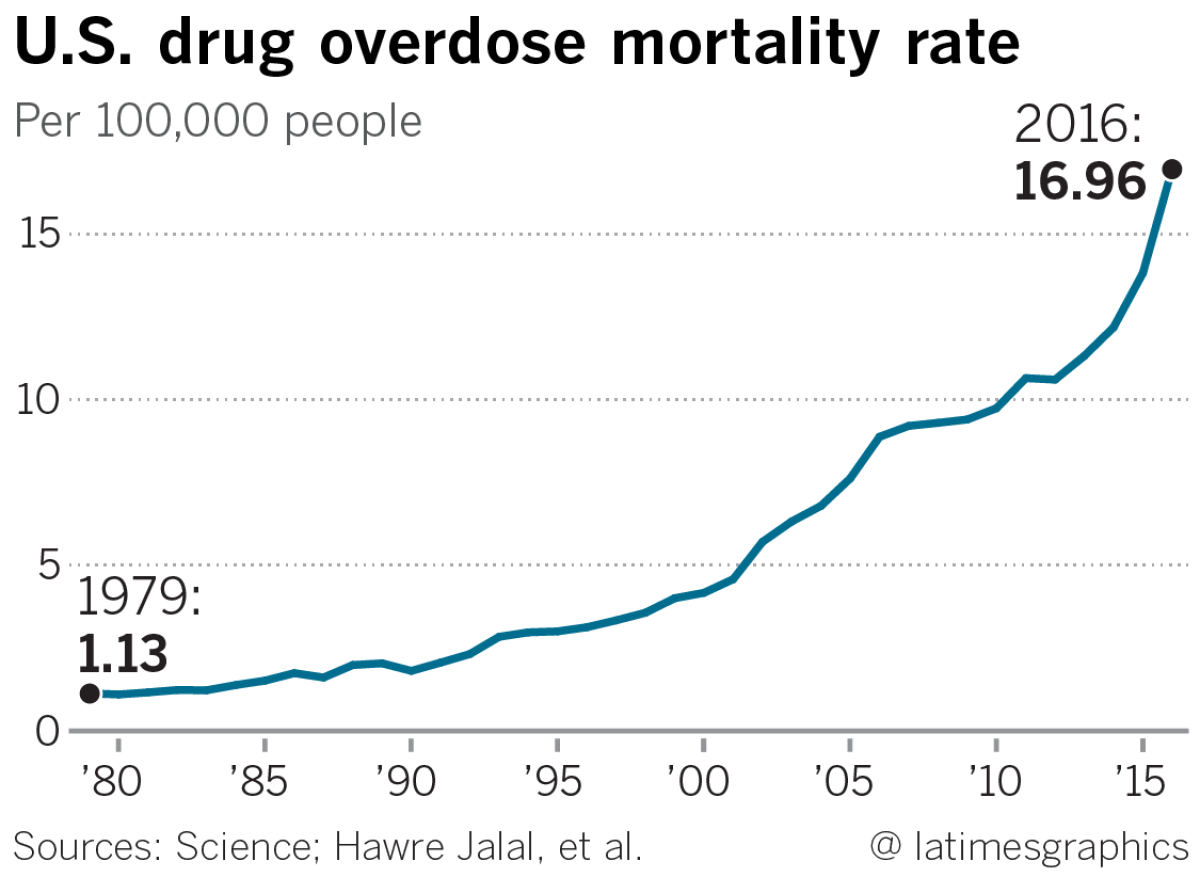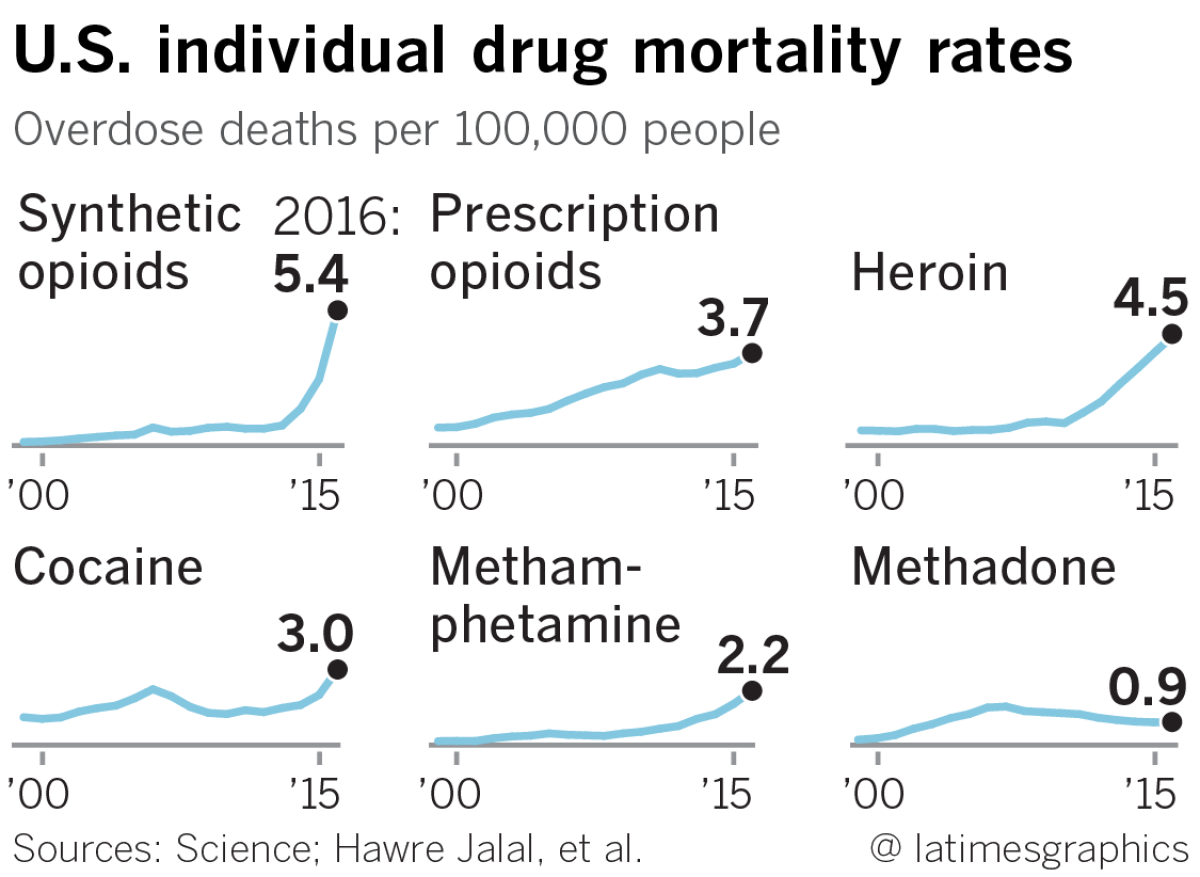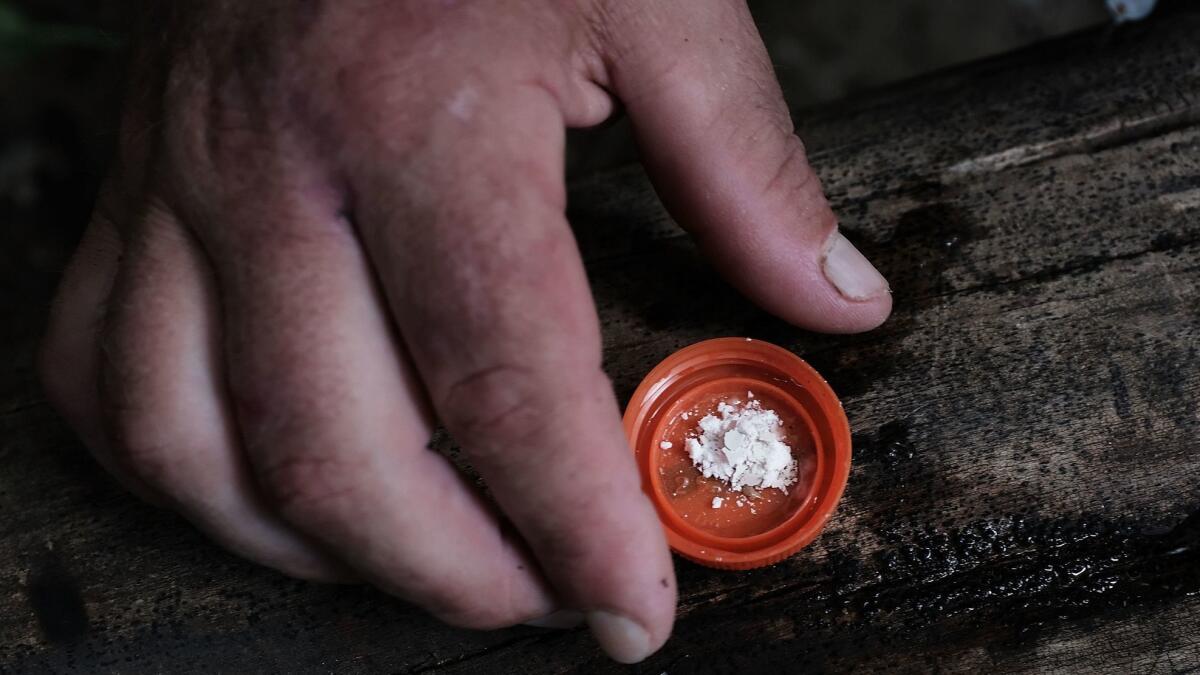Over four decades, an ‘inexorable’ epidemic of drug overdoses reveals its inner secrets

Americans have long construed drugs of abuse as choices. Poor choices that can cost users their lives, to be sure, but choices nonetheless.
But what if drugs of abuse are more like predators atop a nationwide ecosystem of potential prey? Or like shape-shifting viruses that seek defenseless people to infect? If public health experts could detect a recognizable pattern, perhaps they could find ways to immunize the uninfected, or protect those most vulnerable to the whims of predators’ appetites.
In a war against drugs that has yielded few victories and spawned plenty of unintended consequences, these are radical ideas. But a comprehensive new study of drug-overdose deaths aims to give researchers the data they need to discern previously unrecognized patterns in the widening epidemic of drug abuse — and, maybe, to devise policies that really work.
The new research makes clear that over close to four decades, the collective toll of drugs on Americans has followed an upward trajectory that looks less like a steady rise and more like the chain reaction that builds to a nuclear explosion.
The drugs that exact this toll have changed: Methamphetamine, cocaine, prescription narcotics and heroin have all dominated the killing fields of American drug use at some particular time and place.

Put those disparate trend lines together, though, and the curve representing fatal overdoses grows sharply steeper between 1979 and 2016. The death toll from drugs has doubled every eight years, according to the report published Thursday in the journal Science.
“Inexorable,” Dr. Donald Burke, the study’s senior author, called the trend. And frightening, too, since it appears that drug overdose deaths will continue unabated.
That a single, regular pattern of exponential growth would emerge from the combined death tolls of so many distinct drugs was an “aha moment,” said Burke, who studies global public health issues at the University of Pittsburgh.
“It came as a surprise,” he said. But the insight also reinforced his longstanding suspicion “that there are other patterns out there that we sometimes can’t see when we’re standing too close.”

Opioid abuse claimed 49,068 American lives in 2017, and the spreading crisis has galvanized the country. But the new analysis makes clear that prescription painkillers, heroin and synthetic fentanyl (which killed more than 29,000 Americans in 2017) represent only the latest chapter in a history of drug-related deaths that reaches back decades.
Add in the deaths due to cocaine, methamphetamine and a growing number of other drugs and the death toll from overdoses last year reached 72,306. That’s more than the number of American lives claimed by breast cancer and prostate cancer combined.

With greater resolution than ever before, the new research chronicles a scourge of drug-related deaths that has ping-ponged across the country, ravaging new communities from year to year and sometimes abating just as mysteriously — only to explode elsewhere in a different form.
Between 1999 and 2003, for instance, an early spike of cocaine deaths appeared in New Mexico’s north-central counties surrounding Albuquerque. By 2004 to 2007, similar pockets of outsized cocaine-related death rates had metastasized in Florida and North Carolina. And by 2012 to 2016, Ohio, Pennsylvania, West Virginia, Massachusetts and Rhode Island had become cocaine-overdose hotspots.

Heat maps show that from 1999 to 2016, cocaine overdoses exacted their heaviest toll on black men between the ages of 30 and 60, and began surging again in a slightly older population of African American men in 2016.
Unusually high rates of deaths attributed to methamphetamine show up first between 2004 and 2007 in New Mexico, this time in counties to the southwest of Albuquerque, as well as in Nevada and Northern California. By 2012 to 2016, pockets of methamphetamine death would also erupt across Southern California, western Arizona, Oklahoma, and parts of Montana, the Dakotas, West Virginia and Kentucky. These deaths tended to be concentrated among rural white men in their 30s, 40s and 50s.
The birth of the prescription opioid epidemic is evident as early as 1999 to 2003, again scattered across New Mexico but concentrated in the counties surrounding Albuquerque. By 2004 to 2007, hotspots had broken out across Nevada and Northern California, and in Oklahoma, West Virginia, Kentucky and Tennessee. By 2008 to 2011, virtually all of Nevada was suffering a disproportionate rash of opioid deaths, and outsized overdose rates had erupted in pockets across Washington state, the desert counties of Southern California, Florida, southern Ohio and Maine.
Prescription opioid death rates have clustered heavily among white rural men over 40. Of all drug abuse deaths, only prescription opioids — and more recently, heroin and synthetic opioids such as fentanyl — have bitten deeply into the lives of women.
The earliest deaths from synthetic opioids such as fentanyl were seen between 2004 and 2007, almost entirely in West Virginia. By 2008 to 2011, clusters cropped up in eastern Oklahoma and in California’s Lassen County. Between 2012 and 2016, hotspots broke out across northern California, Maine and the midwestern Rust Belt.
Among whites, synthetic opioids in 2016 claimed higher death tolls among men in the prime of their lives — those roughly 25 to 45 years old. But among African Americans, synthetic opioid deaths cut deeply into men between 50 and 60 years old.
The study relies on data from the Centers for Disease Control and Prevention’s National Vital Statistics System, which has not required consistent details of drug-related fatalities to be reported. As a result, county coroners or medical examiners did not always specify the drug or drugs involved, or only listed it as an “opioid” drug. To reflect such cases, Burke’s team lists deaths due to “unspecified drugs” and “unspecified narcotics” as separate categories.
Linda Richter, director of policy research and analysis for the Center on Addiction, said the study results are a stark testament to the failures of the U.S. response to substance abuse.
Health officials have stigmatized addiction, underfunded treatment, and haphazardly responded to the emergence of crises like the epidemic of opioid abuse. That has fueled the unrelenting rise in drug deaths documented by the study, and in the geographic eruptions of drug-related crises it reveals, she said.
“To prevent new drug epidemics, we can’t keep focusing on one drug or another or wait to respond until overdose deaths reach epidemic levels,” said Richter, who was not involved in the study. Something has to change, she added, and this new way of looking at overdose data can shed some light on what should be different.
Burke and his colleagues cited “push” and “pull” factors that may prompt overdose deaths of certain drugs to wax and wane. Experts widely believe, for instance, that the development of abuse-resistant formulations of prescription painkillers, along with depressed prices for street drugs, led many addicted people to abandon prescription drugs in favor of heroin. Meanwhile, “sociological and psychological ‘pull’ forces may be operative to accelerate demand, such as despair, loss of purpose, and dissolution of communities,” the authors wrote.
What clearly emerges from the data is that something profound has happened in the United States since the 1980s to make its citizens more inclined to self-medication and its dangers.
“There’s a treasure trove of information in there,” said Dr. Steven H. Woolf, a physician and public health expert at Virginia Commonwealth University who was not involved with the new study. Researchers will be able to draw on this data to explore the effects — intended and otherwise — of drug trafficking policies, and to decide where in the country to concentrate resources, he said.
“Those details are very valuable,” Woolf said. “But we shouldn’t miss the forest for the trees. The larger question is, why is it that Americans have been dying at greater rates of drug overdose since the 1980s?”
In his own research, Woolf has documented a pattern of declining U.S. life expectancies and linked it to what have been called “deaths of despair,” a powerful confluence of rising rates of suicides, drug overdoses and deaths linked to alcohol abuse. Those trends “all point to this larger issue of Americans reacting to some kind of stressor and some sense of desperation in their lives. And we won’t get control of the drug overdoses unless we identify the root causes that are driving the behavior.”







